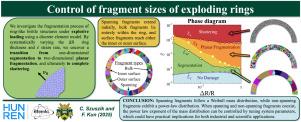Control of fragment sizes of exploding rings
IF 3.8
3区 工程技术
Q1 MECHANICS
International Journal of Solids and Structures
Pub Date : 2025-07-19
DOI:10.1016/j.ijsolstr.2025.113530
引用次数: 0
Abstract
We investigate the fragmentation of ring-like brittle structures under explosive loading using a discrete element model. By systematically varying ring thickness and strain rate, we uncover a transition from one-dimensional (1D) segmentation to two-dimensional (2D) planar fragmentation and, ultimately, to complete shattering. This transition is driven by the effective dimensionality of the crack pattern, which evolves with increasing strain rate. We identify a critical ring thickness beyond which segmentation ceases, and fragmentation directly follows a power-law mass distribution characteristic of 2D systems. In the crossover regime, spanning and non-spanning fragments coexist, enabling control over the power-law exponent of the mass distribution. At very high strain rates, we observe a transition to complete shattering, where the system follows a novel scaling law relating the shattering strain rate to ring thickness. Our results provide fundamental insights into fragmentation universality classes and offer potential applications in space debris prediction, controlled detonation technologies, and materials engineering.

爆炸环碎片大小的控制
本文采用离散元模型研究了爆炸荷载作用下环形脆性结构的破碎问题。通过系统地改变环的厚度和应变速率,我们发现了从一维(1D)分割到二维(2D)平面破碎,并最终完成破碎的过渡。这种转变是由裂纹模式的有效维数驱动的,裂纹模式的有效维数随着应变速率的增加而演变。我们确定了一个临界环厚度,超过该厚度分割停止,碎片直接遵循二维系统的幂律质量分布特征。在交叉状态下,跨越和非跨越碎片共存,从而能够控制质量分布的幂律指数。在非常高的应变速率下,我们观察到一个过渡到完全破碎,其中系统遵循一个新的有关破碎应变速率与环厚度的标度律。我们的研究结果为碎片普遍性分类提供了基本见解,并为空间碎片预测、控制爆炸技术和材料工程提供了潜在的应用。
本文章由计算机程序翻译,如有差异,请以英文原文为准。
求助全文
约1分钟内获得全文
求助全文
来源期刊
CiteScore
6.70
自引率
8.30%
发文量
405
审稿时长
70 days
期刊介绍:
The International Journal of Solids and Structures has as its objective the publication and dissemination of original research in Mechanics of Solids and Structures as a field of Applied Science and Engineering. It fosters thus the exchange of ideas among workers in different parts of the world and also among workers who emphasize different aspects of the foundations and applications of the field.
Standing as it does at the cross-roads of Materials Science, Life Sciences, Mathematics, Physics and Engineering Design, the Mechanics of Solids and Structures is experiencing considerable growth as a result of recent technological advances. The Journal, by providing an international medium of communication, is encouraging this growth and is encompassing all aspects of the field from the more classical problems of structural analysis to mechanics of solids continually interacting with other media and including fracture, flow, wave propagation, heat transfer, thermal effects in solids, optimum design methods, model analysis, structural topology and numerical techniques. Interest extends to both inorganic and organic solids and structures.

 求助内容:
求助内容: 应助结果提醒方式:
应助结果提醒方式:


